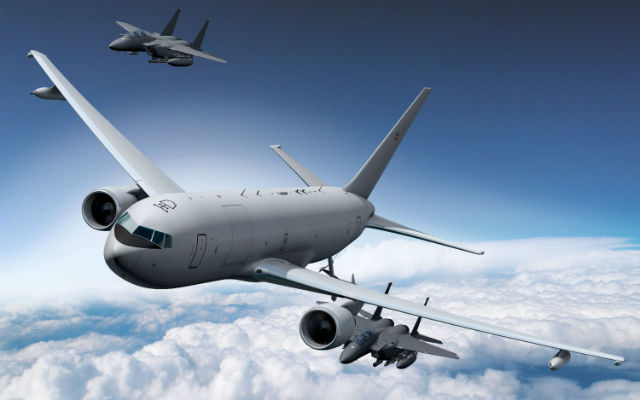Boeing’s first fully-configured KC-46A aerial refuelling tanker has begun its long-awaited first flight, lifting off from Paine Field in Washington today after some weather-related delays.
The 25 September flight to Boeing Field marks a significant step in the next-generation tanker programme, but comes approximately nine months behind schedule and almost five years after the Pegasus entered development.
"During this flight, they’ll check the basic integrity of the aircraft and exercise all the systems – operational checks on engines, flight controls and environmental systems," a Boeing spokeswoman said in statement after takeoff at 1:24pm Pacific Time.
This first flight had been expected in late 2014, but significant missteps such as misplaced wiring and more recently a contaminated fuel system have repeatedly setback the multibillion-dollar development programme, which is working toward a Pentagon “milestone C” low-rate production decision, now expected in April 2016.

Boeing
Boeing’s first 767-2C prototype aircraft recently completed its airworthiness and flutter tests carrying a weight-representative boom and wing aerial refuelling pods (WARPs).
Unlike the 767-2C EMD-1 aircraft, the KC-46A (EMD-2) is fully configured to pass fuel to military receiver aircraft, and its performance over the next five or six months will determine the outcome of the Pentagon’s forthcoming milestone decision and award of the first and second low-rate initial production contracts – for seven and 12 operational aircraft respectively.
With the first flight complete, Boeing has little time to savour the moment and is working against the clock to burn through major test points as quickly as possible. This first flight lends some credibility to the company’s pledge to meet its contractual obligations of delivering 18 operational aircraft by August 2017.
Last week, USAF tanker programme executive Brig Gen Duke Richardson provided a roadmap for completing the development and test programme.
The general expects the KC-46A to release its boom and unreel the WARPs over the next couple of test flights to ensure they deploy and fly correctly.
Once done, EMD-2 will return to the fuel dock to test out the full refuelling system, including the boom, centreline drogue and WARPs. Then, the aircraft will begin free air stability testing and redeploy its boom and drogues as a confidence building exercise.
“We’ll fly the envelope we expect to fly in the milestone C demonstration points and make sure all the stuff is occurring properly,” says Richardson. “This is where we can give the receiver aircraft confidence they actually want to receive fuel from the KC-46, so we’re going to make sure folks are comfortable heading into the aerial refuelling demo.”
To support milestone decision, the KC-46 must pass fuel to six types of military aircraft that operate in varying flight envelopes, including another KC-46.

Boeing
Despite the schedule delays and more than $1 billion in cost overruns charged to Boeing, Richardson has confidence the company will deliver.
“When the fuel contamination hit, I thought it was going to take a lot longer than 30 days to get that airplane back out on the fuel dock,” he says. “[Boeing development chief Scott Fancher] was able to bring in resources from Boeing Commercial – additional mechanics – and they actually got that airplane rebuilt very, very quickly. I’m not going to give up on them, but as time goes on we’ll see if there’s realism in that confidence.”
If all goes according to plan, Boeing can expect orders for 179 tankers through 2028 and maybe more further along.
The KC-46 will eventually recapitalise the 53-year-old KC-135 and 31-year-old KC-10.
Source: FlightGlobal.com
















